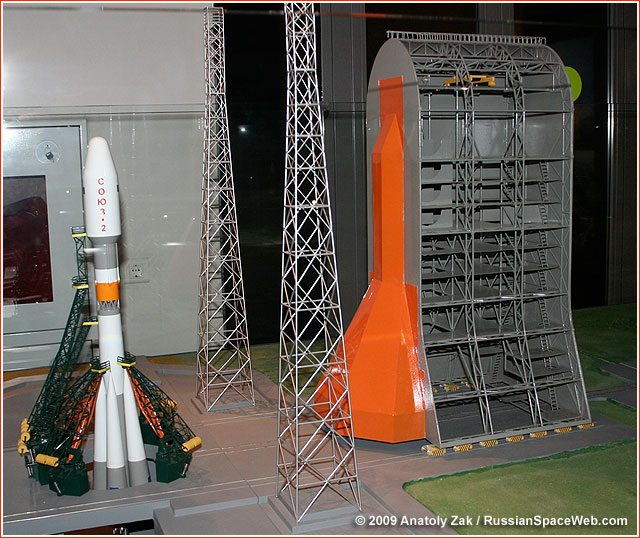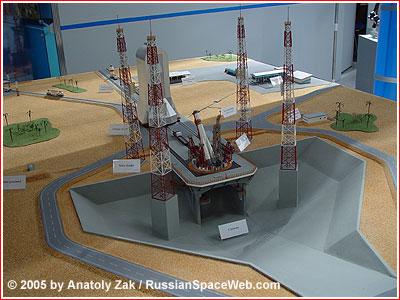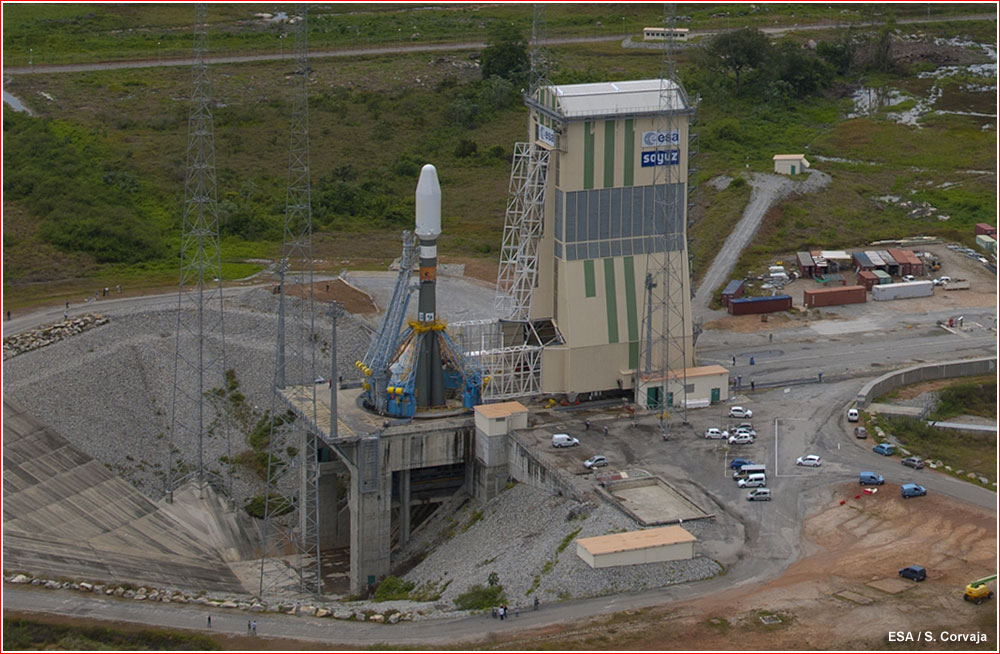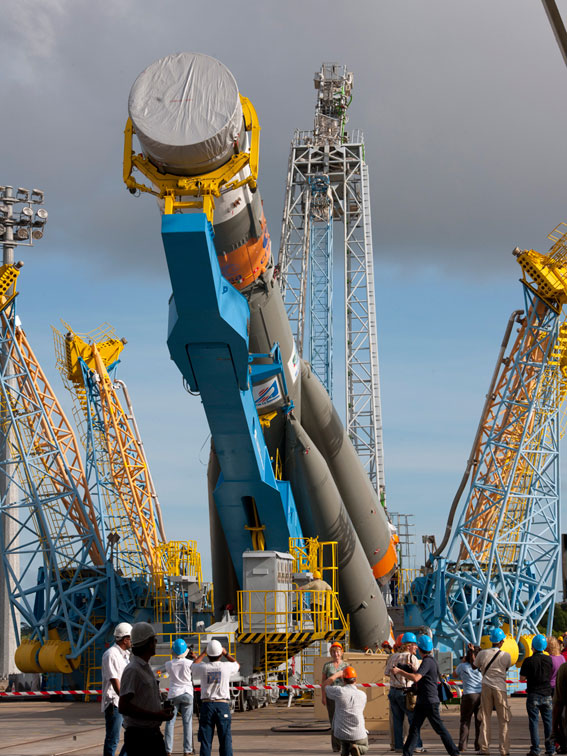http://www.russianspaceweb.com/kourou_els_design.html




The Soyuz launch complex in Kourou was built for as many as 50 launches of the Soyuz rockets over a 15-year period, with three-four missions annually, before the first refurbishment of the facility would be required. The launch facility is located some 12-13 kilometers northwest of the Ariane launch complex in Kourou. The closest residential town -- Sinnamary -- lies 18 kilometers northwest from the Soyuz pad and the main residential area of the Guiana space center -- Kourou -- is 27 kilometers away in opposite direction.
--------------------------------------------------------------------------------
Cost
A price tag of the construction was expected to be 344 million Euro, with the European Space Agency, ESA, contributing 203 million Euro, Arianespace 121 million Euro and Europe adding another 20 million Euro. The Russian contractors would be paid 121-130 million Euro for manufacturing and installing launch equipment. European companies took responsibility for the development overall infrastructure of the complex. The cost of the project later increased significantly, with France bearing 62 percent of expenses. Still, proponents of the project said that it was cheaper than the development of the a whole new family of launch vehicles with similar capabilities.
Technical features
The launch complex for the Soyuz rockets in Kourou, known as ELS, features considerable differences from its original facilities in Baikonur and Plesetsk. Many potential commercial payloads for Soyuz demand vertical integration with the rocket, unlike Russian spacecraft which can be connected to the Soyuz in horizontal position. As a result, engineers decided to install payload module onto the rocket after it was rolled out and erected into vertical position on the launch pad.
Movable gantry
To provide a climate-controlled environment for the integration of payloads with the rocket in the midst of a tropical jungle, a movable service tower was introduced. No such structures ever existed in Baikonur or Plesetsk. The design of the tower could enable its further extension in the future, including accommodations for crew access into the manned spacecraft.
Total height of the gantry reached 52 meters to the top of its curved roof, while its internal movable work platforms provided access to the Soyuz launcher at various levels up to a height of 36 meters. The gantry was designed as a lightweight structure for its size, with a total weight - including its structural framework, work platforms and corrugated external panels - of approximately 800 metric tons. Upon the completion of the Soyuz rocket assembly, the tower would be rolled away 80 meters from the launch pad. Gantry's construction was managed by the French CNES space agency (which oversees operations and infrastructure at the Spaceport), and included Rheinmetall Italy, along with the KBOM General Machine Building Design Bureau and MIR - two of the Russian companies involved in developing the new Soyuz launch site.
In designing the complex, the developers also left the option for the future addition of liquid hydrogen fuel storage, which would enable launches of a new generation of Soyuz rockets powered by cryogenic engines.
MIK
In addition to the launch pad, the Soyuz complex in Guiana also included a processing building (MIK), for horizontal assembly of the rocket, located 700 meters from the pad. The building is equipped with two traveling cranes for handling launcher segments, along with a rail system for the movement and integration of the stages.
Launch pad
The Soyuz launch zone is dominated by its multi-level launch pad and a massive 149-meter wide by 123-meter long flame duct excavated into layers of soil and granite - making it one of the largest civil construction programs in French Guiana.
Configured after the launch sites at Baikonur and Plesetsk Cosmodrome, the Spaceport's Soyuz launch zone ensures the same acoustic and environmental conditions as experienced during more than 1,700 liftoffs performed from the facilities in Kazakhstan and Russia.
The Spaceport's launch pad is 63.5 meters long, 45.3 meters wide and 16 meters deep. This five-level reinforced concrete structure houses mission equipment, and the top two levels have 15-meter wide openings for the launch table and the erected Soyuz vehicle. Its upper area accommodates the launch pad infrastructure, including service tower, fueling booms and erector.
Where the Spaceport's installation differs from Soyuz Cosmodrome launch sites is the use of an eight-level, mobile launch service tower. This 53-meter tall, 24-meter wide structure is rolled from its parked position onto the launch pad, providing a controlled working environment for the vertical integration of Soyuz' upper composite - consisting of the mission payload, Fregat upper stage and payload fairing.
Launch control center
Situated behind the assembly building is a rear zone area which comprises the Soyuz launch site's support facilities – including air conditioning and power systems, offices, telecommunications infrastructure and the launch control center, located one kilometer from the launch pad. This reinforced structure is the only building in the Soyuz launch zone that is occupied during final countdown and liftoff. This three-story facility houses the equipment, consoles and offices for the mission control team.
Upgrades for manned missions
Upgrade for manned missions is also possible, however it would require taking the launch pad out of service for a certain period of time. (218) During the meeting of the International Space Station partners on March 2, 2006, the head of the European Space Agency, ESA, denied the existence of any plans to launch manned missions on the Soyuz-ST from Kourou, however he added "never say never."
The processing sequence
Launcher stages are delivered via a rear receiving dock, and vehicle assembly is performed inside the integration building's air conditioned main bay. The launcher's assembly is handled horizontally, following the same proven procedures used for Soyuz vehicles at the Baikonur Cosmodrome in Kazakhstan and Plesetsk Cosmodrome in Russia.
Completed Soyuz vehicles depart the building on a transporter/erector rail car, which is rolled out to the launch pad for erection, payload integration, final checkout and launch.
[
本帖最後由 七梨護風 於 2-1-2012 21:23 編輯 ]